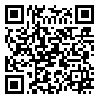Volume 78, Issue 12 (March 2021)
Tehran Univ Med J 2021, 78(12): 835-842 |
Back to browse issues page
Download citation:
BibTeX | RIS | EndNote | Medlars | ProCite | Reference Manager | RefWorks
Send citation to:



BibTeX | RIS | EndNote | Medlars | ProCite | Reference Manager | RefWorks
Send citation to:
Hemmati F, Hashemi Z, Yazdani N. Comparing transcutaneous bilirubin versus serum bilirubin measurement using spectrophotometry for jaundice screening of full-term neonates. Tehran Univ Med J 2021; 78 (12) :835-842
URL: http://tumj.tums.ac.ir/article-1-11068-en.html
URL: http://tumj.tums.ac.ir/article-1-11068-en.html
1- Department of Pediatrics, Neonatal Research Center, School of Medicine, Shiraz University of Medical Sciences, Shiraz, Iran.
2- Neonatal Research Center, Shiraz University of Medical Sciences, Shiraz, Iran.
2- Neonatal Research Center, Shiraz University of Medical Sciences, Shiraz, Iran.
Abstract: (1609 Views)
Background: Neonatal jaundice is an almost common problem among neonates that may cause complications such as kernicterus in severe cases. Since early diagnosis and proper treatment of neonatal jaundice is vital to prevent the related complications, it is necessary to check bilirubin before discharging the neonates. There are several evaluating and diagnostic methods to measure the level of bilirubin. Thus, this study aimed to compare the transcutaneous method versus measurement of serum bilirubin, using spectrophotometry for jaundice screening of full-term neonates before discharge from hospital.
Methods: This observational analytic study was conducted on six hundred neonates with birth weight more than 2000 grams and gestational age more than 35 weeks from September 2012 to March 2013 in Hafez hospital, Shiraz University of Medical Sciences. Parameters such as bilirubin level of neonates were measured and compared, using spectrophotometry and transcutaneous by Bili check with multi waves.
Methods: This observational analytic study was conducted on six hundred neonates with birth weight more than 2000 grams and gestational age more than 35 weeks from September 2012 to March 2013 in Hafez hospital, Shiraz University of Medical Sciences. Parameters such as bilirubin level of neonates were measured and compared, using spectrophotometry and transcutaneous by Bili check with multi waves.
|
Results: Six hundred neonates were enrolled in this study. The Pearson correlation test showed that there was a significant correlation between the two methods of the transcutaneous versus measurement of serum bilirubin, using spectrophotometry (r=0.63), (P>0.05). There was no significant difference between the mean of measured bilirubin, using each method in some demographic variables such as the different groups of gender (P=0.896), birth weight (P=0.419), and type of feeding in neonates (P=0.323), but it was significant in other demographic variables such as the different groups of gestational age and post-neonatal age (P<0.0001). Also, the results revealed that there was a significant correlation between two methods of the trans cutaneous versus measurement of serum bilirubin, using spectrophotometry based on demographic variables (P<0.0001).
Conclusion: In general, the bilirubin measurement using trans-cutaneous method may estimate bilirubin significantly less than the serum bilirubin measurement method, and this difference can be more obviously noticeable in infants with less gestational age and also less post-natal age. |
Type of Study: Original Article |
| Rights and permissions | |
 |
This work is licensed under a Creative Commons Attribution-NonCommercial 4.0 International License. |





